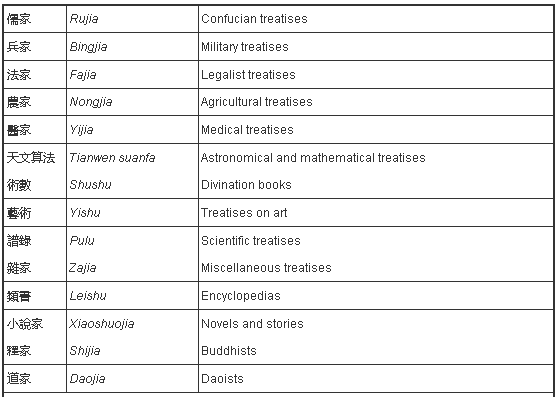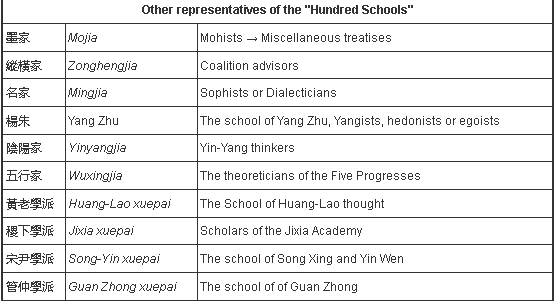The category of "masters and philosophers" (zibu 子部) is the third of the four traditional categories (sibu 四部) into which Chinese literature was divided. The writings assembled in this category are quite heterogenous. Some are philosophical, others scientific, and a third part is a loose aggregation of descriptive notes. The term zi 子 is therefore not very easy to translate. The "masters and philosophers" were, during the Han period汉 (206 BCE-220 CE), divided into Confucians (rujia 儒家), Mohists (mojia墨家), sophists (mingjia 名家), legalists (fajia 法家), Yin-Yang thinkers(yinyangjia 阴阳家), theoreticians of the Five Progresses (wuxingjia 五行家),Daoists (daojia 道家), coalition advisors (zonghengjia 纵横家), miscellaneous thinkers (zajia 杂家), agriculturalists (nongjia 农家) and novelists orstorytellers (xiaoshuojia 小说家). Military theoreticians (bingjia 兵家) were in the beginning seen as a different group. With the growing amount of books written, the categories of astronomy and astrology (tianwen 天文),mathematics and calendar (lishu 历数), as well as medical treatises (yifang医方) had to be incorporated into the literary categories. Technical skills were from the Tang period 唐 (618-907) on also part of the masters category. Later on, Buddhism was not any more a foreign religion, but Chinese monks started compiling Chinese treatises on Buddhism. At the same time the corpus of religious Daoist writings grew abundantly. The writings of the two religions had therefore also to be considered. Under the dominance of Confucian scholars, the two were always put at the end of the masters category and included only the most important writings. Thecollectaneum Siku quanshu 四库全书 includes 2,984 books in this category.







